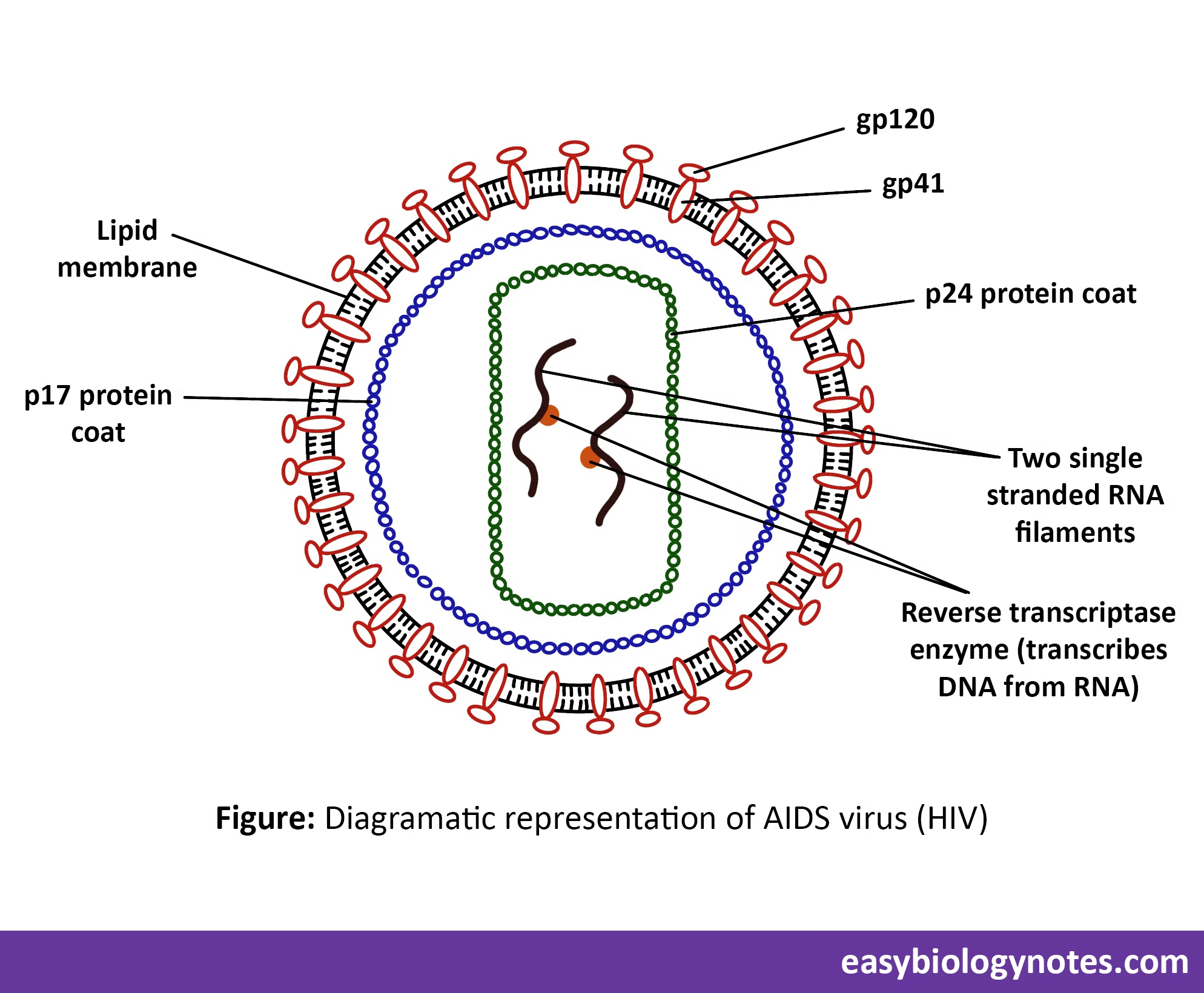What is HIV/AIDS virus?
- HIV (Human immunodeficiency virus) is a retrovirus that belongs to the genus Lentivirus, part of the family Retroviridae.
- It is the causative agent of AIDS (Acquired Immunodeficiency Syndrome).
(AIDS is a condition in humans in which progressive failure of the immune system allows life-threatening opportunistic infections and cancers to thrive) - HIV destroys the CD4 T-lymphocyte cells that play an important role in regulating many processes of the immune system and affects the brain and spinal cord (CD4).
- HIV was discovered by Luc Montagnier and colleagues at the Pasteur Institute, Paris, in 1983.
Human Immunodeficiency Virus structure
- HIV is different in structure from other viruses.
- It is roughly spherical with a diameter of about 120 nm, around 60 times smaller than a red blood cell.
- Virus is covered by a lipid bilayer and projecting knob-like glycoprotein spikes (GP120 and GP41) derived from the host’s cell membrane, making the outer envelope of the HIV virus.
- Two copies of positive-sense single-stranded RNA, associated with reverse transcriptase enzyme, form the central core, which is enclosed by proteins.

Transmission of HIV/AIDS virus
HIV is transmitted via blood and semen:
- Transfusion of infected blood or blood products.
- Use of contaminated needles, syringes, and razors.
- Sexual intercourse with an infected partner.
- From infected mother to child through the placenta.
- Artificial insemination.
- Organ transplant.
Symptoms, Diagnosis, and Treatment of AIDS
- The symptoms of HIV infection include:
Fever, lethargy, pharyngitis, nausea, headache, rashes, etc. - ELISA (Enzyme-linked immunosorbent assay), Western blot test, and viral load test are used to diagnose AIDS. Western blotting test is employed for confirmation of ELISA-positive cases.
- Although there is no cure for AIDS, the use of certain drugs like Zidovudine and Didanosine can prolong the life of an AIDS patient.
*(ART (Antiretroviral therapy) is the use of a combination of HIV medicines to treat HIV infection) - No vaccine has been prepared so far against the AIDS virus.
Prevention of AIDS
The following steps may help in preventing AIDS:
- People should be educated about AIDS. Every year, December 1st is recalled as World AIDS Day. It is one of the methods to educate people about AIDS.
- Blood test must be done in blood donors, donors of semen, donors of organs (kidney, lung, liver), patients undergoing haemodialysis, and pregnant women.
- Disposable needles and syringes should be used. Used needles and syringes must be destroyed.
- In sexual relationship, one should be monogamous (having sexual relationship with only one partner at a time).
- Dentists should use sterilized equipments.
- Avoid tattoos, ear and nose piercing from unqualified people.
- Avoid use of common blades in barber’s shop.
Mode of action of HIV/AIDS virus (HIV life-cycle)
- HIV attacks and destroys the CD4 cells (CD4 T lymphocyte) of the immune system.
CD4 cells are a type of white blood cell that play a major role in protecting the body from infection. HIV uses the machinery of the CD4 cells to multiply and spread throughout the body. This process, which is carried out in seven steps or stages, is called the HIV life cycle. - The seven stages of the HIV life cycle are:
1) Binding
2) Fusion
3) Reverse transcription
4) Integration
5) Replication
6) Assembly
7) Budding
Detailed Steps of the HIV Life Cycle:
1) Binding (also called attachment):
HIV binds (attaches itself) to receptors on the surface of a CD4 cell.
2) Fusion:
The HIV envelope and the CD4 membrane fuse (join together), which allows HIV to enter the CD4 cell.
3) Reverse transcription:
Inside the CD4 cell, HIV releases and uses reverse transcriptase (an HIV enzyme) to convert its genetic material — HIV RNA — into HIV DNA. The conversion of HIV RNA to HIV DNA allows HIV to enter the CD4 cell nucleus and combine with the cell’s genetic material — cell DNA.
4) Integration:
Once inside the CD4 cell nucleus, HIV releases integrase (an HIV enzyme). HIV uses integrase to insert (integrate) its viral DNA into the DNA of the CD4 cell.
5) Replication:
Once integrated into the CD4 cell DNA, HIV begins to use the machinery of the CD4 cell to make long chains of HIV proteins. The protein chains are the building blocks for more HIV.
6) Assembly:
New HIV proteins and HIV RNA move to the surface of the cell and assemble into immature (non-infectious) HIV.
7) Budding:
Newly formed immature (non-infectious) HIV pushes itself out of the host CD4 cell. The new HIV releases protease (an HIV enzyme). Protease acts to break up the long protein chains that form the immature virus. The smaller HIV proteins combine to form mature (infectious) HIV.